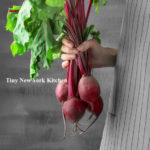Heart healthy beets are packed with nutrients and are perfect for late winter meals. You will love them for their vibrant color, sweet flavor, and versatility.
There are just 60 calories in 1 cup of beets. While low calorie, beets are also packed with potassium, iron, vitamin C, and heart healthy nitrates. The greens are rich in vitamins A and K. Try using beets in soups and sautés.
While red beets are the most common variety, other varieties of beets do exist. Golden beets, as their name implies, are a golden yellow color. Chioggia beets contain red and white stripes on the inside, which is why they are often referred to by their nickname – candy cane beets.
To store fresh beets, separate the leaves from the root and place in separate plastic bags in the refrigerator. The greens should be used within a few days while the roots can last up to two to three weeks.
To peel uncooked beets, use a vegetable peeler to remove the thin skin. For roasted beets, use a paper towel to gently rub off the skins. This gives you a better grip and helps keep beet juice from staining your hands.
Beet juice has been used as far back as the 16th century for makeup, hair dye, and fabric dye. It’s still used commercially as a natural food coloring and clothing dye.
To remove beet juice stains from your cutting board, sprinkle with salt and rub with a lemon half before rinsing. You can remove stains from your hands by rubbing them with a little baking soda, then washing with soap.
Beets are high in nitrates, natural compounds that may help lower your blood pressure and help your body use oxygen more efficiently. Many pro athletes and Olympians drink beet juice to improve their performance.
Beets get their deep red color from compounds called betalains, which have strong antioxidant and anti-inflammatory properties.
37% of the recommended daily intake of folate for adults is in 1 cup of raw beets. Folate needs increase during pregnancy, as this vitamin helps babies develop in the womb, making beets a great addition to a pregnant woman’s diet.
©Tiny New York Kitchen © 2021 All Rights Reserved
Is there anything better than ripe, juicy summer tomatoes? Tomatoes shine in salads, as toast toppers, and in pasta.
Heirloom tomatoes are grown from seeds that have been passed down through generations and are not modified in any way. They come in hundreds of varieties.
The tomato is technically a fruit because it contains seeds. Still, in 1893, the U.S. Supreme Court ruled to classify it as a vegetable since that’s how it is used in cooking.
Unripe tomatoes won’t ripen in the fridge. Keep them on your counter until they are ready to eat.
The first tomatoes to arrive in Europe were called love apples, apples of paradise and golden apples. Some were considered too pretty to eat and used as table decorations.
22 pounds of tomatoes are eats per person per year in the U.S. About half of that comes in the form of ketchup and tomato sauce.
30,000 is the number of tomatoes produced in one year by the world’s largest tomato plant. They were grown in the greenhouses at Disney World.
25% of your recommended daily amount of vitamin C is in 1 medium tomato. Tomatoes are also high in vitamin A, vitamin E, and lycopene (an antioxidant that can improve your heart health and lower your cancer risk.
“Work With What You Got!”
©Tiny New York Kitchen © 2020 All Rights Reserved
I like to eat seasonal fruits and vegetables. Brussels sprouts are a hearty winter vegetable and are sweetest and most tender after a hard frost. They are a good source of fiber, antioxidants, and vitamin C. Look for young, small green sprouts that have tightly formed buds. Avoid any yellowing, which means that the sprouts will be bitter, sulfurous, and tough. Use fresh sprouts within a few days after purchasing. Sprouts sold on the stalk tend to keep longer. Brussels sprouts can be boiled, braised, or steamed. Cut an X at the base of each sprout to allow for a more even cooking. Add a bit of butter, olive oil, salt, pepper, garlic, onions, or herbs of your choice. Brussels sprouts also make a nice addition to stir fry, noodles, and other dishes. As always, be creative and “work with what you got!”
“Work With What You Got!”
© Victoria Hart Glavin Tiny New York Kitchen © 2017 All Rights Reserved








